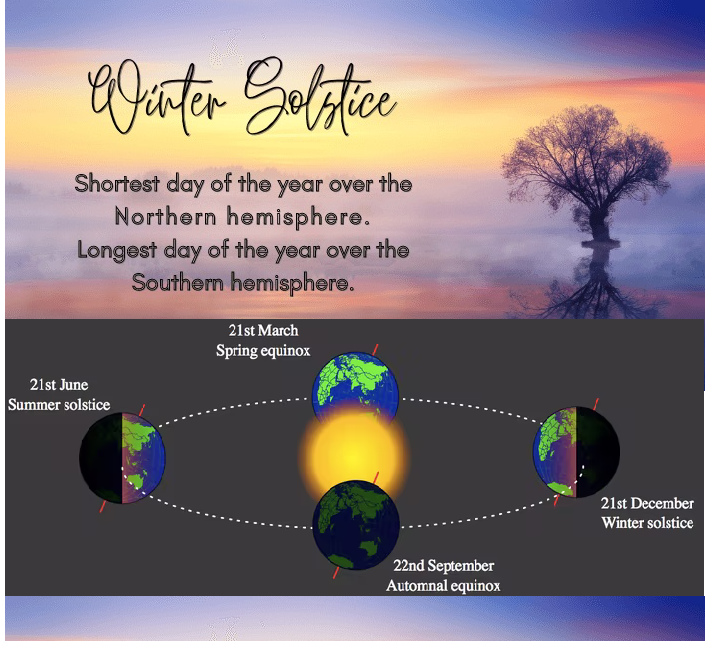Winter Solstice is one of the oldest celebrated holidays across the globe. It occurs on December 21st each year and marks the first official day of winter. It also happens to be the shortest day of the year, as well as a unique time when the sun sets and rises in the same part of the sky.

Most people count the whole day as the December Solstice. However, the solstice is actually at a specific moment – when the Sun is exactly overhead the Tropic of Capricorn. This year it occurs onThursday, December 21st 2023 at 7:27 PM Pacific Time.
- The term solstice comes from the Latin word solstitium, meaning ‘the Sun stands still.’ This is because on this day, the Sun reaches its southern-most position as seen from the Earth. The Sun seems to stand still at the Tropic of Capricorn and then reverses its direction. It’s also common to call it the day the Sun turns around.
Winter is often mistaken for the time of the year when we go into darkness. But Autumn is the season when we dive further into the darkness. At the fall equinox, it’s as if the lights get turned out after a bright summer. All of a sudden, we get sleepier sooner in the evening.
The days get shorter and shorter, darker and darker until we reach Winter Solstice. On this day in the Northern Hemisphere, the shortest day of sunlight, we hit bottom and, from here, bounce back up into the light. In the Southern Hemisphere, it is the summer solstice, the longest day of the year, and flips the light switch in the other direction—from light to descending into darker days (yep, each day of summer is declining in light).
The Winter Solstice is the celebration of coming INTO THE LIGHT—a rebirth. This is the day the New Year calendar begins for many indigenous cultures because it is NATURE’S NEW YEAR. A starting over, a beginning—rebuilding in light and energy. Our body rhythms respond in synchronicity with nature’s light signals.
Because of this (for us humans), winter ends up being more about anticipating spring because of the cold and darkness. Rather than sleeping more, we begin to wake up and slowly stir. Throughout the day, we get busier and busier as we get closer to the spring equinox. Watch for it. You’ll see.
Each day from now until the summer solstice in June, we will pick up, on average, 2 minutes of sunlight each day. By the time we reach the summer solstice, we will have added six more hours of daylight!
Although winter seems to be the season of dormancy, darkness, and cold, the December Solstice marks the “turning of the Sun” and the days slowly get longer. Celebrations of the lighter days to come and nature’s continuing cycle have been common throughout cultures and history with all the feasts, festivals, and holidays around December Solstice time that take place. The Winter Solstice is the Reason for the Season!
In it’s simplest form, it’s a great day to gather with your loved ones, enjoy each others’ company, and celebrate the beginning of a new winter together!
Golden Milk
Golden milk is a delicious drink loaded with antioxidants that may provide an array of health benefits, ranging from a healthier brain and heart to stronger bones, improved digestion and a lower risk of disease.

Turmeric has many science-based health benefits—it’s loaded with antioxidants, and may reduce inflammation and joint pain, improve memory and brain function, protect against heart disease, lower blood sugar levels, improve digestion, just for starters! Turmeric also benefits mental health and mood.
Everyone can benefit from the anti-inflammatory and high-antioxidant activity of golden milk. You can drink it anytime of the day. It’s warming at night and wonderfully delicious any time of year. Golden milk is also very easy to make at home anytime.
Ingredients
- 1 ½ cups light coconut milk (or sub other dairy-free milk of choice)
- 1 ½ cups unsweetened plain almond milk
- 1 ½ tsp ground turmeric
- 1/4 tsp ground ginger (or 1 tsp freshly grated ginger*)
- 1 whole cinnamon stick (or 1/4 tsp ground cinnamon)
- 1 Tbsp coconut oil (optional for richness // see notes for oil-free)
- 1 pinch ground black pepper
- Sweetener of choice (i.e. maple syrup, coconut sugar, or stevia to taste)
Instructions
- To a small saucepan, add coconut milk, almond milk, turmeric, ginger, cinnamon, coconut oil (optional), black pepper, and sweetener of choice (I usually add 1 Tbsp (15 ml) maple syrup // adjust amount if altering number of servings).
- Whisk to combine and warm over medium heat. Heat until hot to the touch but not boiling – about 4 minutes – whisking frequently.
- Turn off heat and taste to adjust flavor. Add more sweetener to taste or more turmeric or ginger for intense spice + flavor.
- Serve immediately, dividing between two glasses. Sprinkle with some cinnamon or add a cinnamon stick. Best when fresh, though leftovers can be stored covered in the refrigerator for 2-3 days. Reheat on the stovetop or microwave until hot.
Notes *If using fresh ginger, use a fine mesh strainer when serving to strain out the ginger for a creamy texture.
*If oil-free, consider using a coconut milk with decent fat content (canned vs. boxed). *You can add a sprig of peppermint too for a pop of color.

